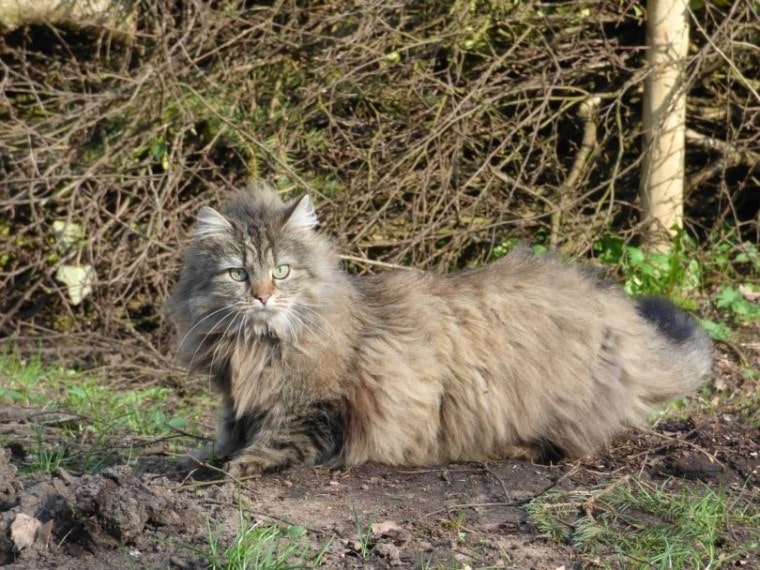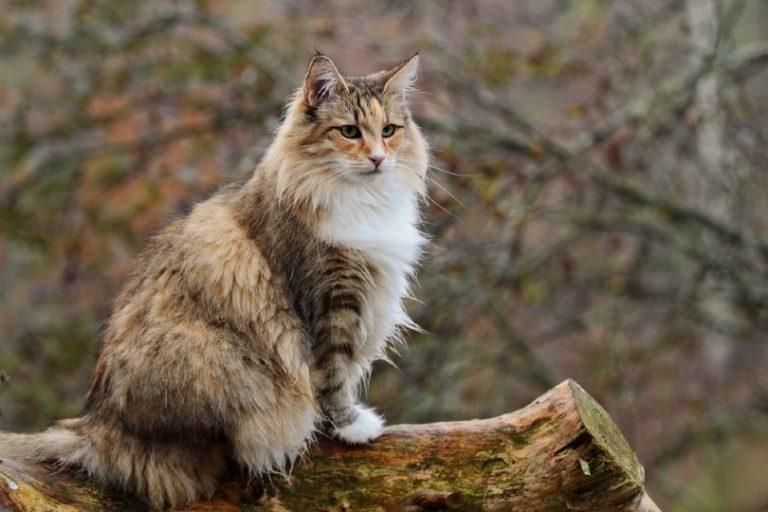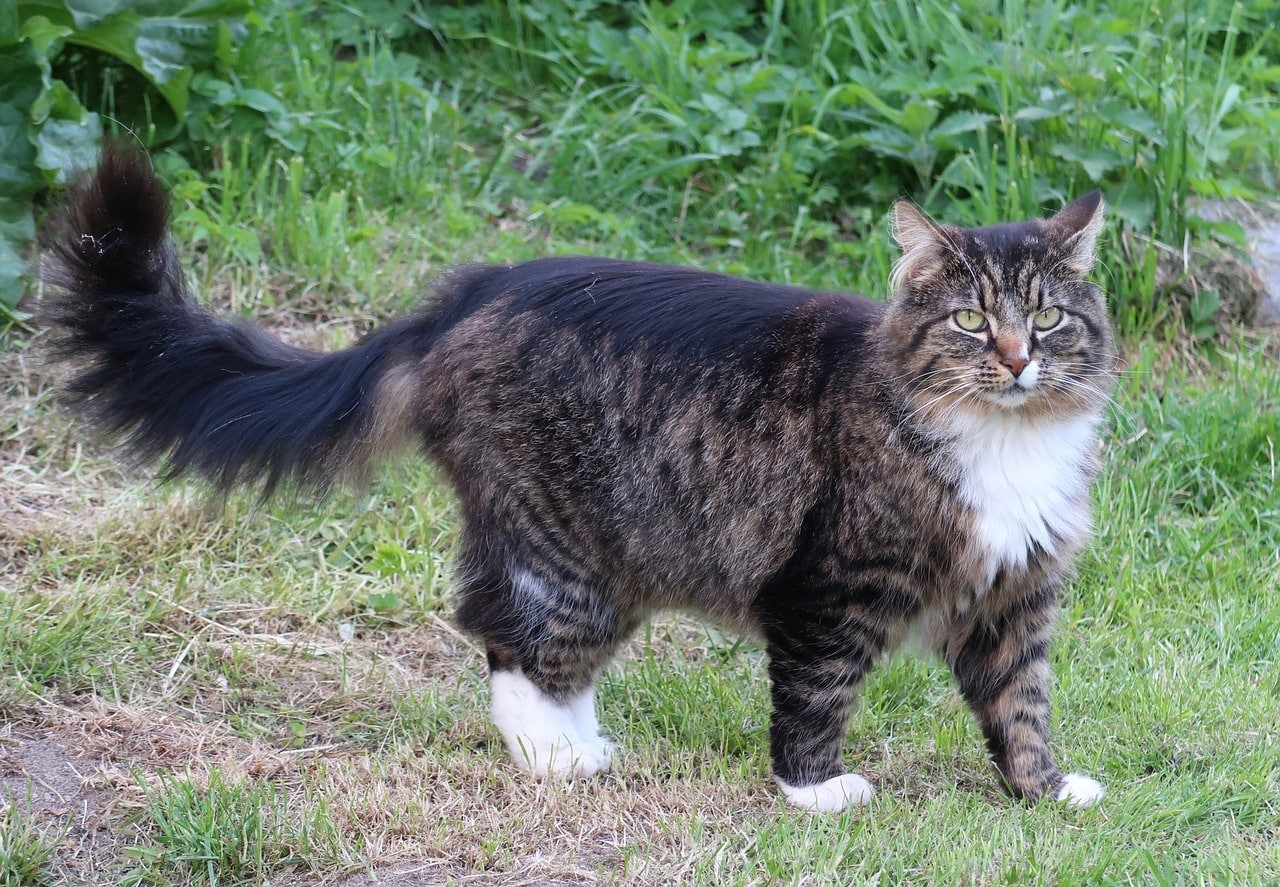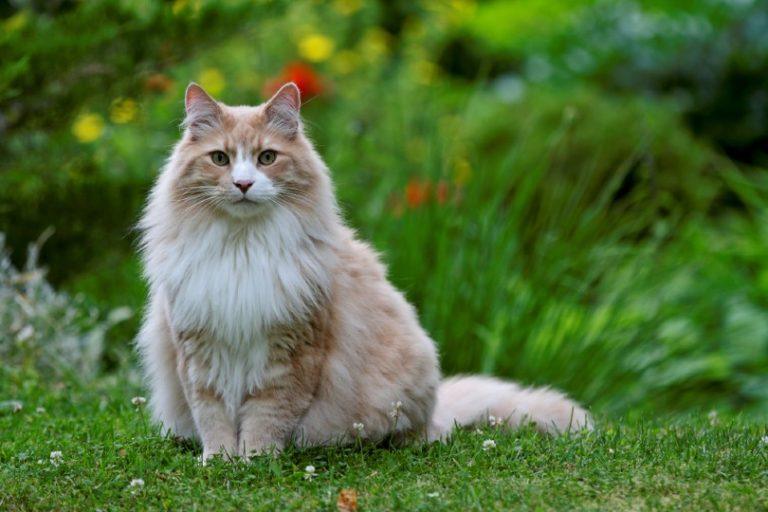
Click Below to Skip Ahead
The Norwegian Forest Cat is a large cat breed from Northern Europe adapted to colder climates due to its thick fur. It’s an ancient Viking breed first seen around 1000 BC.
Breed Overview
Height:
9 – 12 inches
Weight:
12 – 16 pounds
Lifespan:
14 – 16 years
Colors:
White/black, ebony/red, orange/blue
Suitable for:
Children, seniors, families, other pets
Temperament:
Sweet, loving, athletic
If you are interested in getting one of these longhair cats for your home, keep reading while we take a closer look at the Norwegian Forest cat to learn more about their temperament, health problems, exercise requirement, breeding history, and more to help you make an informed purchase.
Norwegian Forest Cat Characteristics
Norwegian Forest Cat
Norwegian Forest Cats are pretty costly, especially if you are interested in a show-quality cat from a well-known breeder. Your location compared to the closest breeder can also affect the cost quite a bit, and cats from the west coast can also cost more. There is more to the price of your Norwegian Forest Cat than the purchase cost. You will also need to pay for vet visits, food, treats, toys, and much more.
Temperament & Intelligence of the Norwegian Forest Cat
The temperament of the Norwegian Forest Cat is sweet and lovable even though it often has a rough and rugged appearance. These cats enjoy sitting on your lap and will never be far from a member of the family. It’s a favorite among children that love its long hair and fluffy appearance, and friendly nature. It loves to play games and will spend several hours a day chasing a laser or ball.
The Norwegian Forest Cat is also easy to train and can learn several tricks if you have the patience to spend a few minutes a day teaching them. Consistency is key when training, and they will soon follow several commands and come when you call them.
Are These Dogs Good for Families? 👪
Yes. As we mentioned earlier, children love the cuddly appearance of the Norwegian Forest Cat, and it doesn’t mind if you pet it or carry it around. It’s also suitable for the elderly because of its ability to be independent. Its intelligence also helps it learn the routines of its owners, so it is less bothersome than some other breeds. It’s always at the door when you come home from work and often likes to jump up in bed with you while you sleep.
Does This Breed Get Along with Other Pets?
Yes, The Norwegian Forest Cat gets along well with other cat breeds and is never aggressive. Its large size usually causes other cats to leave it alone, and it’s muscular enough to be a formidable opponent for many dogs, so it usually has few enemies. It will chase birds and rodents, like mice and hamsters, so you will need to be careful if you have these pets in your home.

Things to Know When Owning a Norwegian Forest Cat :
Food & Diet Requirements 
Your Norwegian Forest cat can eat any brand of cat food that is healthy and provides your pet with a well-balanced meal. Brands with high-quality meat protein like chicken, beef, tuna, salmon, turkey, or lamb listed as the first ingredient are the best choice. These meats will provide your cat with the protein it needs for energy and to build muscle. Cats are carnivorous, so protein from meat is the most important ingredient. We recommend a dry kibble because it helps clean teeth by scraping away plaque and tarter. Wet cat food is good for kittens, older cats, and cats with a medical condition that requires it. Follow the instructions on the package closely to avoid overfeeding your pet which can lead to weight gain.
Exercise 🐈
You won’t need to set aside much time to exercise with your cat because it will get plenty during its daily activities, especially if you have a large family or other pets to keep it busy. We recommend spending 15–30 minutes each day engaging your cat in high-intensity activities, like chasing a laser or a ball to help them get their heart moving. These high-energy activities can help your cat burn off excess calories and will make them less likely to cause mischief, especially if you do it right before bed.
Training 🧶
Unfortunately, cats aren’t able to learn tricks as well as dogs, even smart breeds like the Norwegian Forest Cat, but with a little practice, you might be surprised at how well your cat learns. You can teach it to tell you when it needs to go outside to use the bathroom, or even how to use the toilet instead of the litter box. You can teach it to jump o your lap on command and come when you call it. It will retrieve toys by name, choose a dinner it wants to eat, learn how to sing, and much more.
Training requires plenty of patience and treats, but all you need to do is keep motioning what you want the cat to do and give it a treat when it does it. Never look angry or disappointed or the cat will see you as hostile and move on to doing something else. Cats have very short attention spans, so you need to be ready at all times. Holding training sessions at specific times each day will also increase your chance of success because the cat will get into a routine, especially if there are treats involved.

Grooming ✂️
The Norwegian Forrest Cat has a long, dense coat that will require a significant amount of brushing to keep it tangle-free but will require very little maintenance beyond that. The waterproof nature of the coat helps keep odor at a minimum, and it also seems to repel dirt, so these cats rarely need a bath unless they get into something. It would be helpful if you manually brushed the teeth with a cat toothpaste to help prevent the onset of dental disease, and you may need to trim the nails occasionally if it won’t use a scratching post to keep it from tearing up the furniture.
Health and Conditions🏥
Serious Conditions:
Hypertrophic Cardiomyopathy
Hypertrophic Cardiomyopathy is a form of heart disease that affects many cat breeds, including the Norwegian Forest Cat. This condition affects the left ventricle and its ability to pump blood. Symptoms include a loss of appetite, weak pulse, and difficulty breathing. Cats with this condition will need a restricted sodium diet and other specialized care.
Hip Dysplasia
Hip Dysplasia is a condition that results from a malformed hip joint. It progresses much faster in overweight cats and also in large cat breeds like the Norwegian Forest Cat. Symptoms of hip dysplasia include difficulty getting up and a decrease in their daily activity. You may also notice a bunny hopping gate when they walk. Weight control and medication can help a cat with this condition live a longer and happier life.
Minor Conditions:
Dental Disease
Dental disease is a serious issue for cats, and many experts believe more than half of cats over the age of three have some form of it. Dental disease can make it painful to chew, and it can also cause your pet to become more aggressive, especially toward other pets. Manual brushing with a cat-safe toothpaste and regular checkups is the best way to prevent dental disease from affecting your cat.
Male vs Female
The primary difference between the male and female Norwegian Forest cat is size. The males are much larger than the females and tend to look a little scruffier. However, there are very few other differences between the two sexes, especially if you get them spayed or neutered, which is better for their health, and it might be a requirement with some breeders.
3 Little-Known Facts About the Norwegian Forest Cat
1. Norwegian Forest Cats Have A Thick Waterproof Coat
Norwegian Forest Cats have a thick double coat that allows the cat to feel comfortable in temperatures that would send other cats looking for shelter. The coat is also waterproof so they don’t mind the rain and will even swim on occasion if they need to.
2. King Olaf Named The Norwegian Forest Cat the National Cat Of Norway
Breeders finalized the Norwegian Forest Cat breed, and then King Olaf named it the official cat of Norway due to its strong yet majestic appearance. They did not export these cats until the 1970s, and the first ones arrived in the United States in 1979.
3. Norwegian Forest Cats Love To Climb
Norwegian Forest Cats are notorious for their climbing ability, and you will often find them on the roof or high up in a tree if you allow them to go outdoors. Unlike many other breeds, these cats usually don’t get stuck and are quite squirrel-like in their climbing ability.

Conclusion
The Norwegian Forest cat is a large and cuddly cat that will make an excellent pet in any home. It’s friendly, gets along with children and other pets, and will be waiting at the door when you get home. It likes to climb, so you will want to set up a few perches around your home, and you will also want to get your lap ready to be an often-used resting place for a 20-pound cat. It has very few health problems and a long lifespan, so it’s sure to give you and your family many years of fond memories.
We hope you have enjoyed reading over this guide and found it helpful for answering your questions. If we have convinced you to purchase one of these cats, please share this guide to the Norwegian Forest Cat on Facebook and Twitter.
Featured Image Credit: Pixabay








